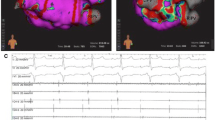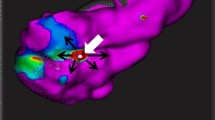Abstract
Introduction
Left atrial geometry provided by preprocedural MRI/CT imaging studies is often used to guide pulmonary vein isolation. Rapid 3D reconstruction of the left atrium (LA) can be obtained using multielectrode catheters in conjunction with electro-anatomical mapping (EAM) and can also be used to guide ablation. The objective of this study is to assess the accuracy of electro-anatomical left atrial maps acquired with the multispine catheter by comparing them to CT and MRI images.
Methods
Forty patients undergoing ablation for atrial fibrillation were studied. All patients underwent preprocedural CT/MRI imaging. 3D reconstructions of the LA were obtained using a multispine catheter with the Ensite/NavX mapping system. The operator was blinded to the results of the preprocedural imaging studies while acquiring the LA maps.
Results
Mean map acquisition time was 10.3 ± 3.0 min. There was a strong correlation between maximum pulmonary vein (PV) ostial length and intervein distances measured on the electro-anatomical maps and on the CT/MRI images. Moreover, 11 patients had right middle PVs which were detected during map acquisition. Six out of nine (67%) early branches of the right inferior PV and three out of three (100%) early branches of right superior PV were also identified. In two patients, one branch of the left superior PV and one branch of the left inferior PV were not detected during mapping.
Conclusion
Left atrial anatomical maps acquired using multielectrode catheters in conjunction with EAM are accurate and provide information regarding pulmonary vein dimensions and geometry which is similar to that obtained with CT/MR imaging.




Similar content being viewed by others
References
Arentz, T., Weber, R., Burkle, G., et al. (2007). Small or large isolation areas around the pulmonary veins for the treatment of atrial fibrillation? Results from a prospective randomized study. Circulation, 115(24), 3057–3063.
Nademanee, K., McKenzie, J., Kosar, E., Schwab, M., Sunsaneewitayakul, B., Vasavakul, T., et al. (2004). A new approach for catheter ablation of atrial fibrillation mapping of the electrophysiologic substrate. J Am Coll Cardiol, 43(11), 2044–2053.
Hocini, M., Sanders, P., Jais, P., et al. (2004). Techniques for curative treatment of atrial fibrillation. J Cardiovasc Electrophysiol, 15(12), 1467–1471.
Pappone, C., Rosanio, S., Oreto, G., et al. (2000). Circumferential radiofrequency ablation of pulmonary vein ostia: a new anatomic approach for curing atrial fibrillation. Circulation, 102(21), 2619–2628.
Malchano, Z. J., Neuzil, P., Cury, R. C., Holmvang, G., Weichet, J., Schmidt, E. J., et al. (2006). Integration of cardiac CT/MR imaging with three-dimensional electroanatomical mapping to guide catheter manipulation in the left atrium: Implications for catheter ablation of atrial fibrillation. J Cardiovasc Electrophysiol, 17, 1221–1229.
Mikaelian, B. J., Malchano, Z. J., Neuzil, P., Weichet, J., Doshi, S. K., Ruskin, J. N., et al. (2005). Integration of 3-dimensional cardiac CT images with real-time electroanatomical mapping to guide catheter ablation of atrial fibrillation. Circulation, 112, e35–e36.
Noseworthy, P. A., Malchano, Z. J., Ahmed, J., Holmvang, G., Ruskin, J. N., & Reddy, V. Y. (2005). The impact of respiration on left atrial and pulmonary venous anatomy: implications for image-guided intervention. Heart Rhythm, 2, 1173–1178.
Caponi, D., Corleto, A., Scaglione, M., Blandino, A., Biasco, L., Cristoforetti, Y., et al. (2010). Ablation of atrial fibrillation: does the addition of three-dimensional magnetic resonance imaging of the left atrium to electroanatomic mapping improve the clinical outcome? A randomized comparison of Carto-Merge vs. Carto-XP three-dimensional mapping ablation in patients with paroxysmal and persistent atrial fibrillation. Europace, 12, 1098–1104. doi:10.1093/europace/euq107.
Pérez-Castellano, Nicasio, Villacastín, Julián, Moreno, Javier, Rodríguez, Aníbal, Moreno, Mauricio, Conde, Asunción, et al. (2005). Errors in pulmonary vein identification and ostia location in the absence of pulmonary vein imaging. Heart Rhythm, 2(10), 1082–1089.
Tada, H., Oral, H., Greenstein, R., Pelosi, F., Jr., Knight, B. P., Strickberger, S. A., et al. (2002). Differentiation of atrial and pulmonary vein potentials recorded circumferentially within pulmonary veins. J Cardiovasc Electrophysiol, 13(2), 118–123.
Hsu, L. F., Jaïs, P., Hocini, M., Sanders, P., Rotter, M., Takahashi, Y., et al. (2005). High-density circumferential pulmonary vein mapping with a 20-pole expandable circular mapping catheter. Pacing Clin Electrophysiol, 28(Suppl 1), S94–S98.
Brooks, A. G., Wilson, L., Kuklik, P., Stiles, M. K., John, B., Shashidhar, et al. (2008). Image integration using NavX fusion: initial experience and validation. Heart Rhythm, 5(4), 526–535. Epub 2008 Jan 17.
Mansour, M., Holmvang, G., Sosnovik, D., Migrino, R., Abbara, S., Ruskin, J., et al. (2004). Assessment of pulmonary vein anatomic variability by magnetic resonance imaging: implications for catheter ablation techniques for atrial fibrillation. Cardiovasc Electrophysiol, 15(4), 387–393.
Kistler, P. M., Rajappan, K., Harris, S., Earley, M. J., Richmond, L., Sporton, S. C., et al. (2008). The impact of image integration on catheter ablation of atrial fibrillation using electroanatomic mapping: a prospective randomized study. Eur Heart J, 29(24), 3029–3036.
Hunter, R. J., Ginks, M., Ang, R., Diab, I., Goromonzi, F. C., Page, S., et al. (2010). Impact of variant pulmonary vein anatomy and image integration on long-term outcome after catheter ablation for atrial fibrillation. Europace, 12(12), 1691–1697.
Acknowledgments
Supported in part by the MGH Deane Institute for Integrative Research in Atrial Fibrillation and Stroke
Disclosures
Jeremy Ruskin: Fellowship support: St Jude
Moussa Mansour: Research Grant and Consultant: St Jude
Others: None
Author information
Authors and Affiliations
Corresponding author
Rights and permissions
About this article
Cite this article
Koruth, J.S., Heist, E.K., Danik, S. et al. Accuracy of left atrial anatomical maps acquired with a multielectrode catheter during catheter ablation for atrial fibrillation. J Interv Card Electrophysiol 32, 45–51 (2011). https://doi.org/10.1007/s10840-011-9573-1
Received:
Accepted:
Published:
Issue Date:
DOI: https://doi.org/10.1007/s10840-011-9573-1




